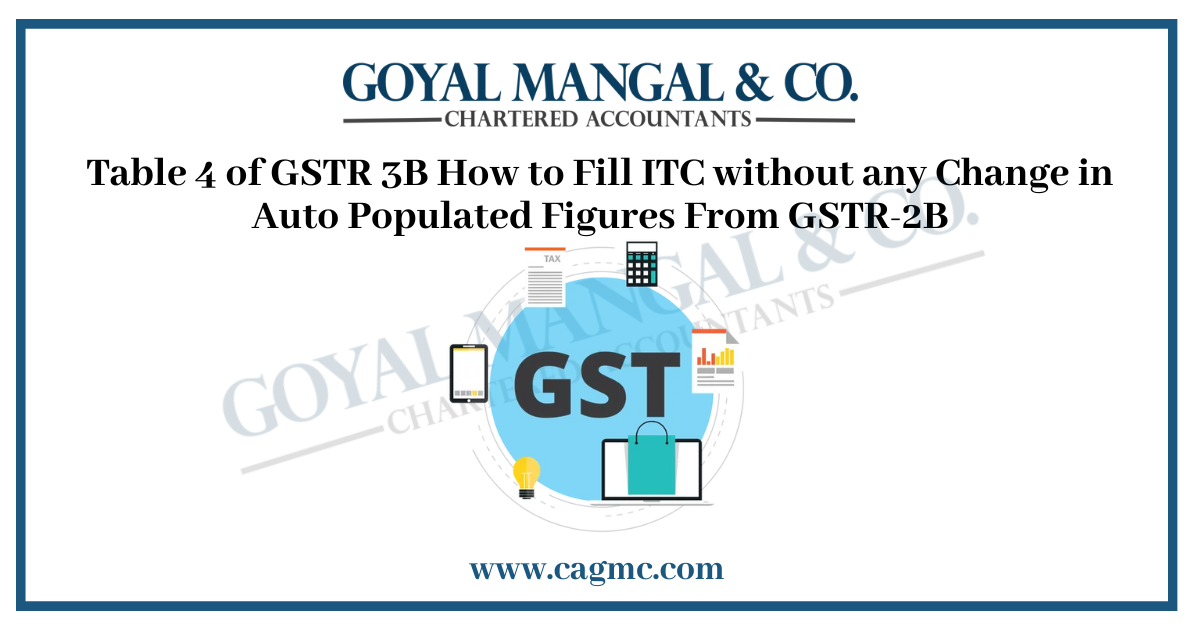
Navigating the compliance of Goods and Services Tax (GST) is a vital term for enterprises in India. Among the several GST returns, GSTR-3B holds specific importance as a monthly summary return. Within this return, Table 4 plays a crucial role generally focusing on Input Tax Credit (ITC). As enterprises are actively working for efficiency and accuracy in their filing of tax compliance, understanding how to easily fill in Table 4 ITC without creating any changes to the auto-populated figures from GSTR-2B is paramount. In the current article, we will discuss 4 Table ITC in GSTR-3B filing.
| Table of Content |
Brief about the GSTR-3B- Table 4 ITC
GSTR-3B is a monthly summary of returns for companies which they need to file. It gives a snapshot of the input tax credit details, the amount of tax payable for the provided tax period, and output tax liability. GSTR-3B is a self-declaration form, which the taxpayers use for their GST liabilities and availment of ITC.
Table in GSTR-3B mainly pertains to the details of ITC. It is a significant section where enterprises are required to give details regarding the ITC they are claiming for a specific tax period. The information generally involves the eligible ITC on inward supplies at the time of tax.
It is significant for enterprises to appropriately fill out Table 4 ITC in GSTR-3B as errors or discrepancies can lead to compliance issues. The figures in the table are generally to determine the final tax liability or refund amount for the tax period.
New Format for Table 4 of GSTR-3B
The new format of Table 4 of GSTR-3B is effective from the August 2022 return period, Table 4 is a government rebuild. Creating ITC reporting in GSTR-3B is a bit more issue. There are four sections in the new table 4 namely sections 4(A), 4(B), 4(C), and 4(D).
Here are the key components generally involved in Table 4 ITC:
- Details of eligible ITC {section 4(A)};
- Ineligible ITC {Section 4(B)};
- Reversal of ITC {Section 4 (C)};
- Other details.
What procedures are to be followed by taxpayers while filing their GSTR-3B?
Here is a general procedure for filing GSTR-3B:
- Login to GST portal;
- Navigate to GSTR-3B;
- Complete table-wise information;
- Compute tax liability;
- Pay taxes by the available modes on the GST Portal;
- Verify the information entered in GSTR-3B before submission to avoid errors;
- After verifying the information, submit the GSTR-3B Return;
- File the return either through digital signature certificate (DSC) or electronic verification code (EVC), according to the taxpayer’s preference;
- After successful filing, a system-generated acknowledgement receipt with a unique reference number is obtained;
- Maintain appropriate records of invoices, copies of the filed GSTR-3B and supporting documents for specified retention time.
GSTR-3B- TABLE 4 ITC- how to file ITC without any change in Auto Populated Figures from GSTR-2B
In GSTR-3B, Table 4 is for reporting the ITC details. In case, one is filing GSTR-3B and wants to fill in the ITC information without making any alterations in the auto-populated figures from GSTR-3B, you can follow the below procedure:
- Login to GST portal and go to the part of GSTR-3B;
- Verify the auto-populated figures in Table 4 for ITC, which is dependent on your GSTR-2B. It is an auto-drafted return for ITC;
- Check GSTR-2B data, before going to GSTR-3B filing, ensure that you reconcile and check data in GSTR-2B;
- Make sure that the auto-populated figures in Table 4 are correct and that no amendments are needed. Then you can further go to fill in other information in GSTR-3B;
- Finish other sections in GSTR-3B such as payment of taxes, outward supplies, and tax liability by filing in the needed information;
- Before submission of GSTR-3B, review the whole information to make sure of accuracy. Once, your review is done thoroughly, submit the form;
- After completion of GSTR-3B, in case there is any tax liability, then make the payment before the due date.
Conclusion
Through this article, one can master the art of filing Table 4 ITC in GSTR-3B without amending auto-populated figures from GSTR-2B. As enterprises strive to examine the complexities of the tax system, gain efficiency and understanding of handling input tax credit, it plays a vital role in making sure that appropriate information is filed so as to minimize the differences risk. By studying the process of this article, enterprises can streamline their tax filing procedures, enhance overall compliance, and reduce the likelihood of errors.
[/column]


